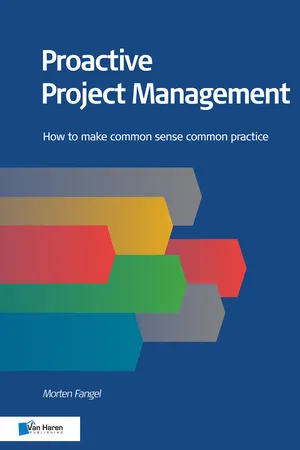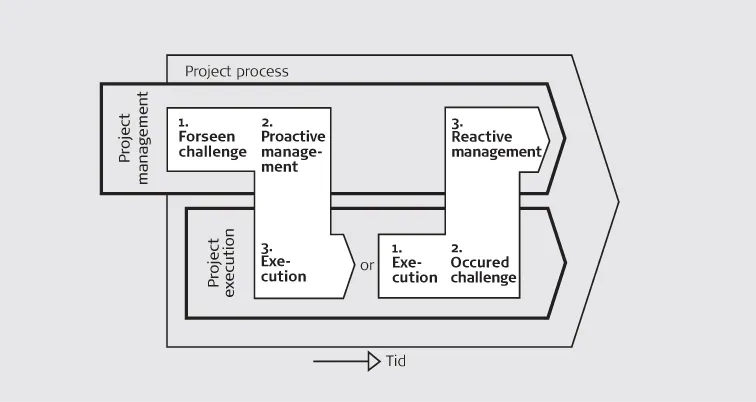
- English
- ePUB (mobile friendly)
- Available on iOS & Android
eBook - ePub
Proactive Project Management
About this book
One mindset is that the project management process itself should be lead. You promote proactive project management by planning and evaluating relevant management initiatives – and by adapting the level of effort and the tools for the project's degree of complexity. The entire book can be considered as a method with tools for such planning and evaluating the project management.
Another mindset is that the project management is not only a task for the project managers. The project owners, the participants and other parties must also be proactively involved in the management process. Such co-management means that the analyses and plans created will become more relevant– and have more impact on the project process. The general tool for such an approach, as presented in this book, is to facilitate the management activities.
The entire book is a supplement to the existing literature on project management. The new mindsets and methods promote the idea of being a more reflective project manager – and thereby gaining even more benefit from knowledge obtained from other books and from personal experiences.
Frequently asked questions
Yes, you can cancel anytime from the Subscription tab in your account settings on the Perlego website. Your subscription will stay active until the end of your current billing period. Learn how to cancel your subscription.
At the moment all of our mobile-responsive ePub books are available to download via the app. Most of our PDFs are also available to download and we're working on making the final remaining ones downloadable now. Learn more here.
Perlego offers two plans: Essential and Complete
- Essential is ideal for learners and professionals who enjoy exploring a wide range of subjects. Access the Essential Library with 800,000+ trusted titles and best-sellers across business, personal growth, and the humanities. Includes unlimited reading time and Standard Read Aloud voice.
- Complete: Perfect for advanced learners and researchers needing full, unrestricted access. Unlock 1.4M+ books across hundreds of subjects, including academic and specialized titles. The Complete Plan also includes advanced features like Premium Read Aloud and Research Assistant.
We are an online textbook subscription service, where you can get access to an entire online library for less than the price of a single book per month. With over 1 million books across 1000+ topics, we’ve got you covered! Learn more here.
Look out for the read-aloud symbol on your next book to see if you can listen to it. The read-aloud tool reads text aloud for you, highlighting the text as it is being read. You can pause it, speed it up and slow it down. Learn more here.
Yes! You can use the Perlego app on both iOS or Android devices to read anytime, anywhere — even offline. Perfect for commutes or when you’re on the go.
Please note we cannot support devices running on iOS 13 and Android 7 or earlier. Learn more about using the app.
Please note we cannot support devices running on iOS 13 and Android 7 or earlier. Learn more about using the app.
Yes, you can access Proactive Project Management by Morten Fangel in PDF and/or ePUB format, as well as other popular books in Education & Architecture General. We have over one million books available in our catalogue for you to explore.
Information
Topic
EducationSubtopic
Architecture General
How to use the book
To benefit from this book, it is important that you have understood its underlying principles. Consequently, in the first chapter, the purpose, the approach and the structure of the book will be explained.
Furthermore, the chapter explains the distinction between low, medium, and high level of the management effort in projects. In the book’s subsequent chapters we are referring to this distinction – as a tool for scaling the management effort in your project.
1.1 The purpose of the book
1.2 The approach of the book
1.3 The structure of the book
1.4 Three management levels
1.5 The book – in brief
1.1 The purpose of the book
The book provides a coherent set of principles, methods and practical hints that can help you to be more proactive when managing your project. Proactive management implies that the management effort takes place before the management challenge arises!
The concept of proactive management has often been expressed as well begun is half completed. Being proactive is both common sense and universally accepted – also for the management of a project: To plan before execution; to see potential risks before they occur; to focus on the whole rather than single parts.
But many examples from practice show that being proactive is not at all natural.
When a project or a new phase in the project is initiated, attention is spontaneously focused on the project content. This is the natural reaction when we start a new task. At the first meeting the project manager might suggest that it would be practical to arrange more than only the next meeting, i.e., some kind of proactive management.
But focus often remains on the project content for as long as possible, because it is the project execution that satisfies our need for professional performance and gives us the experience of being important and interacting with others.
If the participants in the project are competent and prepared for co-operation, we can progress rather far by following our natural tendency to focus on the content of the project. But later in the project, we will typically face problems that are symptoms of a lack of management effort –see the flow to the right in Figure 1.1.1: Some may feel that their interests are not respected; others disagree on the importance of performing according to the plan; there is no presentation ready for the meetings because the presenter thought another person was responsible; the attendance fades away, because nothing really important takes place at the meetings, etc.
Figure 1.1.1 The project includes processes for both management and execution of the project. The interaction between the two could either be proactive or reactive.

As a reaction to such problems in a project, the necessary management effort is mobilized – fire-fighting is needed. Such a reactive management implies that we are only explicitly performing project management when a significant management challenge has occurred – either originating in the environment or from conditions in the project process.
The presented pattern could be seen as a natural law for projects – almost like the power of gravity:
• From the start, and for as long as possible in the process, we focus on the project execution, i.e., the solution of the project task itself.
• Attention given to management aspects is used reactively when challenges threaten the progress of the project.
There are many good reasons for this pattern:
• We are stressed by time – we know perfectly well that a proactive management effort would be preferable, but feel or assume that there is not sufficient time in the moment.
• Uncertainty around the project is too great – we have to know more about the content before a reliable plan can be created.
• Management of the project can be a rather diffuse experience – for many participants, it is much more inspiring to discuss the content.
Part of the explanation is also that it is typically more complex to handle proactive management tasks than reactive ones. Reactive management means to extinguish only one fire – while proactive management means to ensure the entire house against fire.
We do not ensure proactive management of a project simply by trusting in common sense and in what is universally accepted. A conscious effort is needed to counteract the natural law as presented above. The starting point is that you consciously aim at shifting the time spent on project management away from reactive management and toward a more proactive approach in all the project phases.
One way of promoting proactive management is to get the project owner, together with the project manager and the project participants, to recognize this tendency to concentrate on the project execution – even while relevant management tasks in the project are on the agenda.
Part of the story is also that we may call non-active management – i.e. to “turn a deaf ear” toward occurring management challenges, and to hope that they will adjust themselves. In contrast to this lack of involvement, even reactive management appears more positively: Action is needed when the problem occurs!
In brief, to perform proactive project management is not natural for many of us. It is not something we just do because we know that well begun is half completed. My experience tells me that we need principles and concepts that remind us of the importance of proactive management – and methods and tools which in practice help us to overcome the “natural law”.
This book aims at transferring common sense into common practice – by assisting you to become more proactive when managing your project.
1.2 The approach of the book
To perform good project management implies to practise three different areas of competencies:
• Experience application
To have experienced different ways of handling projects and, as a consequence, to be able to reflect and to apply different modes of action in current situations. Part of this project experience is also that your experiences from previous projects help you to keep your nerves steady throughout a project.
• Method application
Includes having explicit knowledge of various methods and tools that could be applied for the handling of project management activities. This competence implies that you know when and how to apply them appropriately. To gain benefit from the application of methods and tools, you must also be able to apply them in an appropriate interaction with the persons involved in the project.
• Leadership behaviour
Deals with being able to perform leadership behaviour that ensures your success with the management of the project in various situations and with different management tasks. This is a matter of establishing trust, handling relationships and facilitating cooperation.
This structure is identical to the structure introduced in the self-assessment tool Competencies in Project Management – also named the Danish National Competence Baseline, NCB. Lit. 2.
As it appears in Figure 1.2.1, the three competencies overlap each other. This indicates that the most competent project management takes place when relevant elements of...
Table of contents
- Cover
- Title
- Colophon
- Contents
- Preface
- Detailed contents
- 1 How to use the book
- 2 Project and Project management
- 3 Leading project management
- 4 Facilitate the management activities
- 5 Project preparation
- 6 Project analyses
- 7 Master project planning
- 8 Project anchoring
- 9 Project start-up
- 10 Detailed project planning
- 11 Manage project execution
- 12 Ongoing project leadership
- 13 Stepwise project follow-up
- 14 Project close-out
- Postscript
- Appendix A Project Model Example
- Appendix B Index and key terms
- Appendix C Other literature by the same author
- Appendix D Project Management Model – for outfolding
- Appendix E Application of project management methods – for outfolding